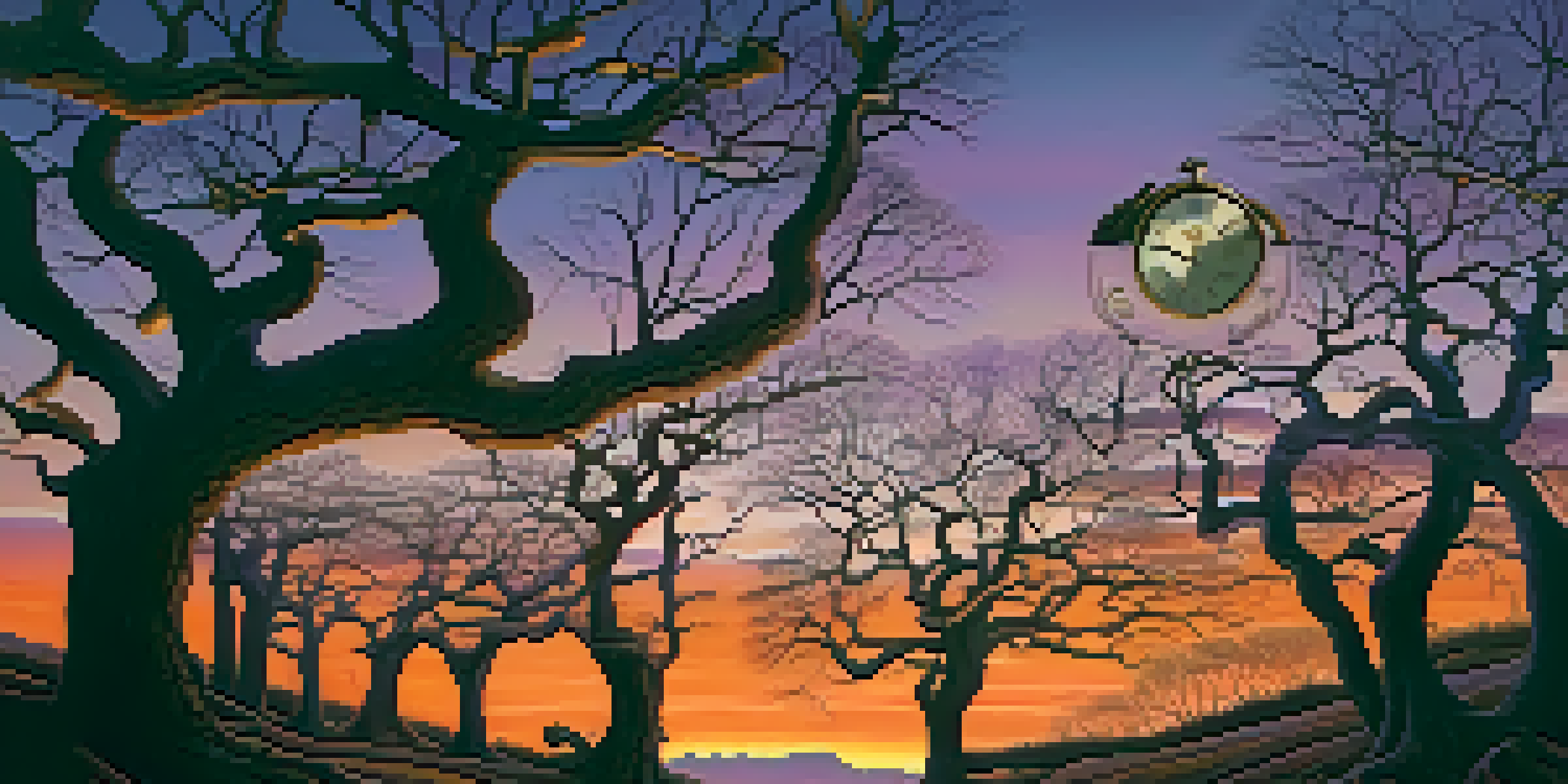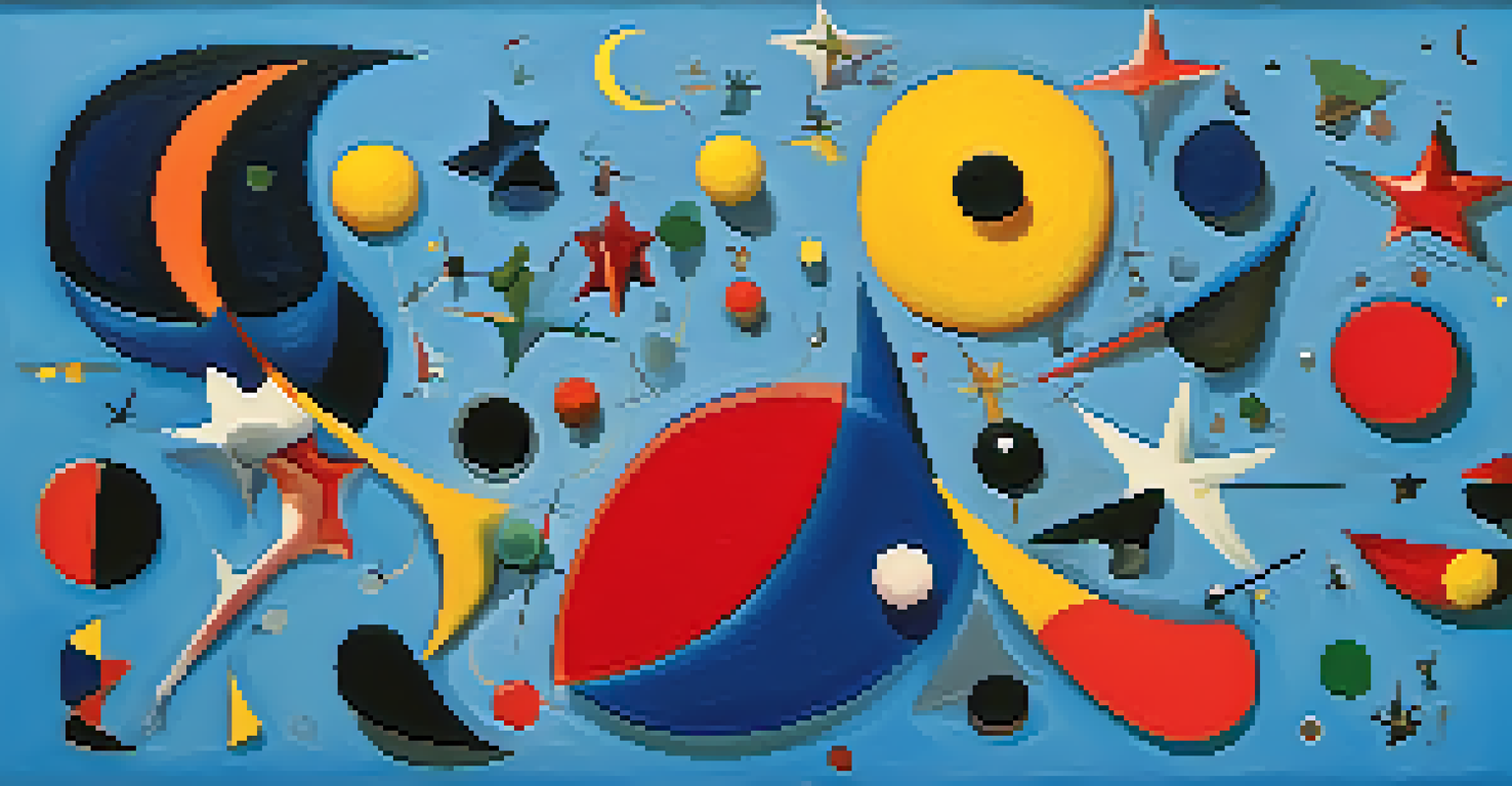Exploring Surrealism in Spanish Art: Key Figures and Styles

The Origins of Surrealism in Spain: A Brief Overview
Surrealism emerged in the early 20th century, captivating artists with its ability to tap into the subconscious. In Spain, this movement blossomed amidst political turmoil and cultural shifts, providing a unique backdrop where dreams and reality intertwined. The Spanish interpretation was influenced by the broader European surrealist movement yet retained distinct regional characteristics.
Surrealism is based on the belief in the superior reality of certain forms of previously neglected associations, in the omnipotence of dream, in the disinterested play of thought.
Key figures like Salvador Dalí and Joan Miró began to explore the depths of their imaginations, challenging traditional artistic norms. They sought to express the irrational and the dreamlike, reflecting the complexities of the human psyche. This rich tapestry of ideas laid the groundwork for a surrealist renaissance in Spain.
Ultimately, the origin of surrealism in Spain is a fascinating blend of historical context and individual creativity, paving the way for innovative artistic expressions that would follow in subsequent decades.
Salvador Dalí: The Master of Surrealist Imagery
Salvador Dalí stands as one of the most iconic figures in surrealism, renowned for his vivid and often bizarre imagery. His works, such as 'The Persistence of Memory', feature melting clocks that challenge our perception of time and reality. Dalí's flamboyant personality and unique visual style made him a household name, transcending the art world.

Beyond his paintings, Dalí's influence extended into film, photography, and literature, showcasing his versatility as an artist. His collaborations with filmmakers like Luis Buñuel resulted in groundbreaking works that blurred the lines between reality and fantasy. Dalí's ability to provoke thought and evoke emotion continues to resonate with audiences worldwide.
Surrealism's Roots in Spain
Surrealism in Spain emerged amid political turmoil, blending historical context with individual creativity to shape a unique artistic movement.
Through his eccentric approach and imaginative themes, Dalí not only defined surrealism but also left an indelible mark on Spanish art and culture.
Joan Miró: A Unique Approach to Surrealism
Joan Miró, another towering figure in Spanish surrealism, had a distinct style characterized by playful shapes and vivid colors. Unlike Dalí's detailed realism, Miró's work often embraced abstraction, inviting viewers to interpret meaning through their own experiences. His pieces, filled with whimsical forms and symbols, resonate with a sense of childlike wonder.
The goal of art was the vital expression of self.
Miró's art reflects the influence of Catalan culture and his desire to break away from conventional artistic techniques. He sought to create a new language of art that communicated his inner thoughts and emotions. This innovative spirit positioned Miró as a key player in the surrealist movement, elevating Spanish art on the global stage.
Through his exploration of imagination and spontaneity, Miró's legacy endures as a testament to the power of creativity in surrealism.
The Influence of the Spanish Civil War on Surrealism
The Spanish Civil War (1936-1939) had a profound impact on the country's artists, shaping their work and perspectives. Many surrealists, including Dalí and Miró, responded to the chaos and violence around them, channeling their emotions into their art. This turbulent period became a catalyst for expressing surrealism's core themes of conflict, identity, and the subconscious.
Artists used surrealism as a means of escaping reality while also confronting it, reflecting the horrors of war through dreamlike imagery. The juxtaposition of beauty and despair in their works invites viewers to grapple with the complexities of human experience. This era solidified surrealism's role as a powerful tool for social commentary.
Dalí and Miró's Lasting Impact
Salvador Dalí and Joan Miró defined Spanish surrealism through their distinct styles, influencing both art and culture on a global scale.
In essence, the Spanish Civil War not only influenced the themes within surrealism but also highlighted the resilience of artists who sought to find meaning amidst adversity.
Key Styles of Surrealism in Spanish Art
Surrealism in Spanish art encompasses various styles that reflect the diversity of its practitioners. From the meticulous detail of Dalí's hyper-realistic landscapes to the playful abstraction of Miró, these styles highlight the movement's versatility. Artists often employed techniques like automatism, which encourages free-flowing creativity without conscious control.
Another notable style is the use of dream symbolism, where everyday objects are transformed into fantastical elements, challenging our perceptions of reality. This approach invites viewers to engage with the artwork on a deeper level, unraveling layers of meaning that reside within their subconscious. The interplay between dreams and reality remains a hallmark of Spanish surrealism.
Overall, the styles of surrealism in Spain reflect a rich tapestry of influences and techniques, showcasing how artists navigated their inner worlds while responding to external realities.
The Legacy of Surrealism in Contemporary Spanish Art
The legacy of surrealism continues to shape contemporary Spanish art, influencing a new generation of artists. Many modern creators draw inspiration from the techniques and themes established by their surrealist predecessors, exploring the boundaries of reality and imagination. This evolution demonstrates the enduring impact of surrealism on artistic expression.
Contemporary artists often blend surrealism with other styles, creating hybrid forms that resonate with today's audiences. The exploration of identity, technology, and social issues through a surreal lens remains prevalent, showcasing how the movement adapts to modern contexts. This dialogue between past and present enriches the Spanish art scene.
Surrealism's Ongoing Legacy
The legacy of surrealism continues to inspire contemporary Spanish artists, reflecting its adaptability and relevance in today's art scene.
In essence, the legacy of surrealism serves as a foundation for ongoing exploration and innovation, ensuring its relevance in contemporary artistic practices.
Exploring Surrealism: Exhibitions and Cultural Events
Art exhibitions and cultural events dedicated to surrealism play a vital role in preserving and celebrating this movement. Various galleries and museums across Spain host exhibitions that showcase the works of surrealist masters like Dalí and Miró, alongside contemporary artists influenced by their legacies. These events foster a greater appreciation for surrealism and its contributions to art history.
In addition to traditional exhibitions, cultural festivals often feature performances, workshops, and lectures that delve into surrealist themes. These gatherings provide opportunities for audiences to engage with the art and ideas, encouraging dialogue and exploration. Such initiatives invigorate the art community and inspire new generations of artists and art lovers.

As we explore surrealism through exhibitions and cultural events, we not only honor its past but also pave the way for its future within the vibrant landscape of Spanish art.
Conclusion: The Enduring Allure of Surrealism in Spain
In conclusion, surrealism has carved a unique niche in Spanish art, interweaving history, culture, and imagination. The movement's key figures, including Dalí and Miró, have left an indelible mark, influencing countless artists and shaping the way we perceive art today. Their exploration of the subconscious and the dreamlike continues to resonate with audiences around the world.
Surrealism in Spain serves as a testament to the resilience of creativity in the face of adversity, reflecting the complexities of human experience. As contemporary artists build upon this foundation, they ensure that the spirit of surrealism remains alive and relevant in today's artistic landscape.
Ultimately, the allure of surrealism in Spanish art lies in its ability to transcend boundaries, inviting us all to explore the depths of our own imaginations.